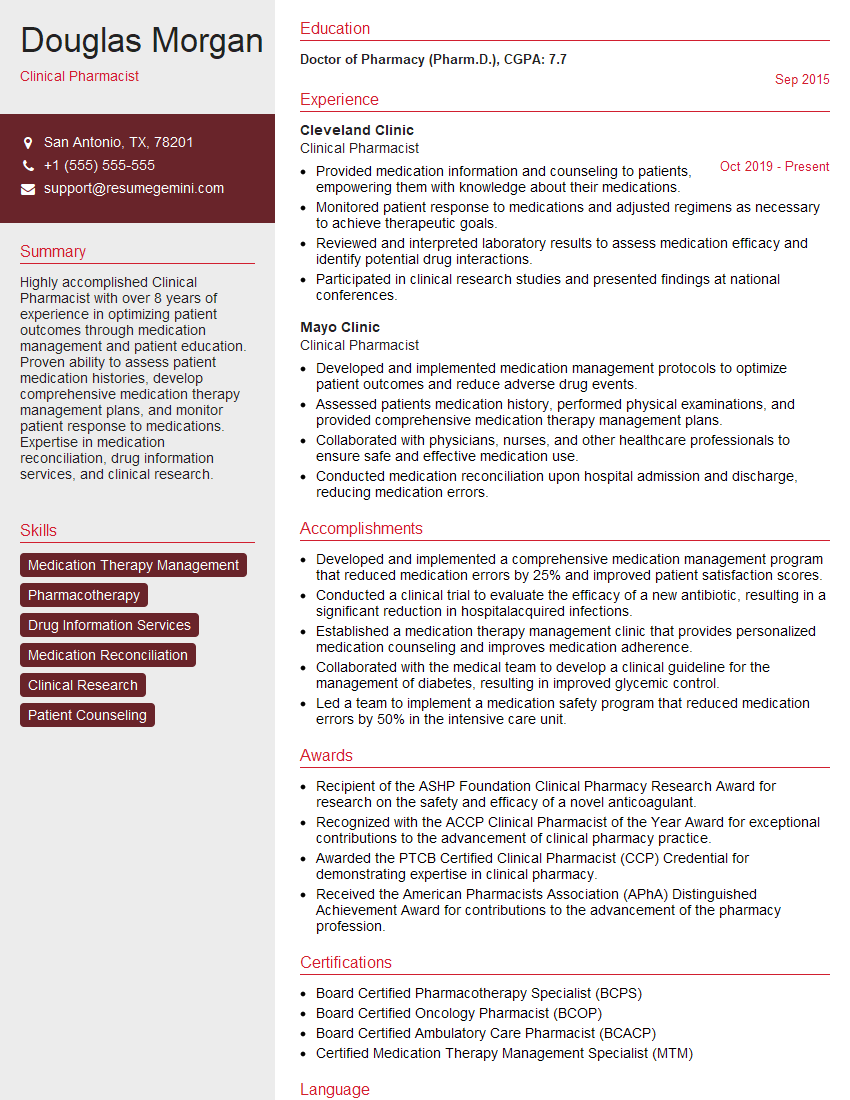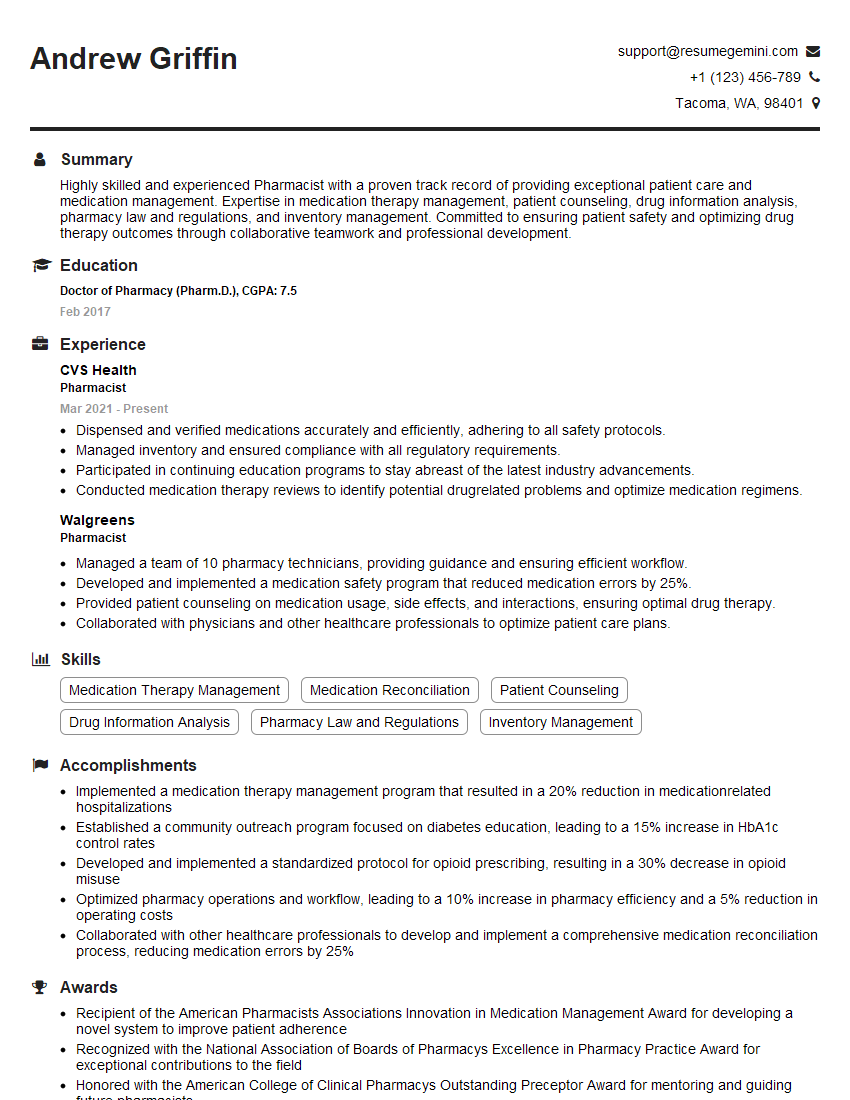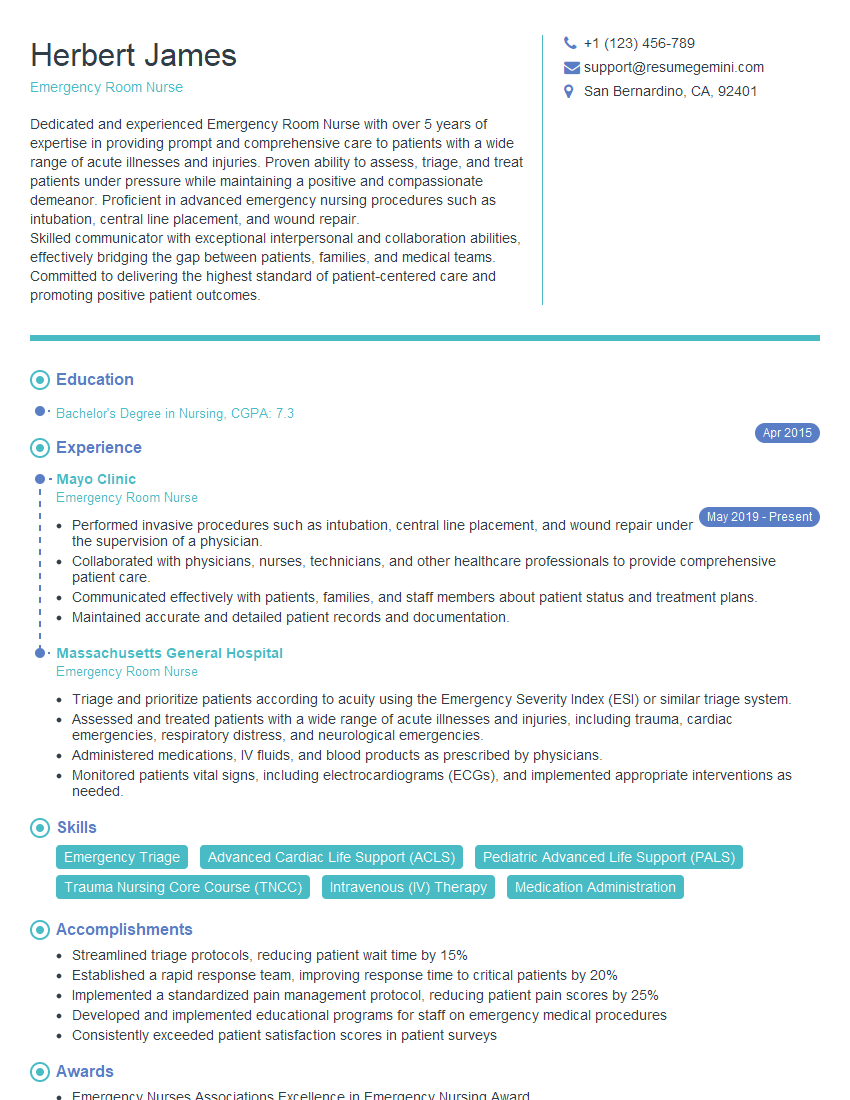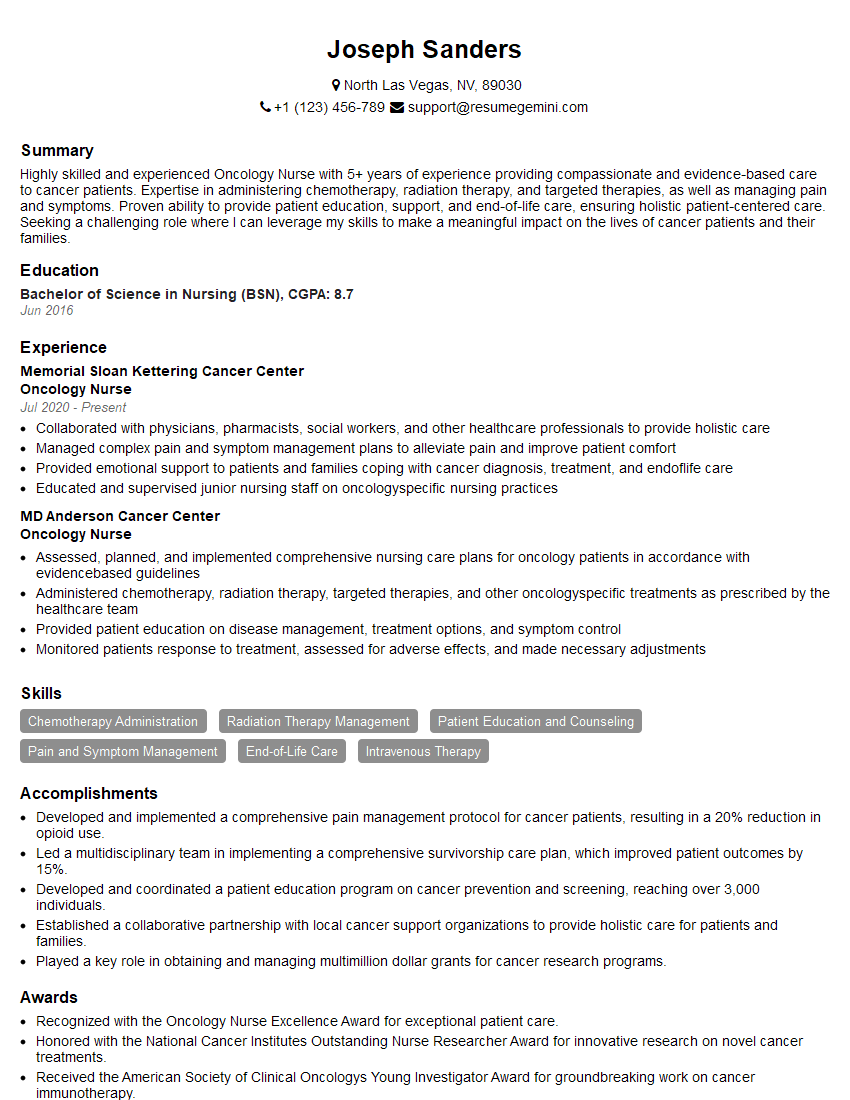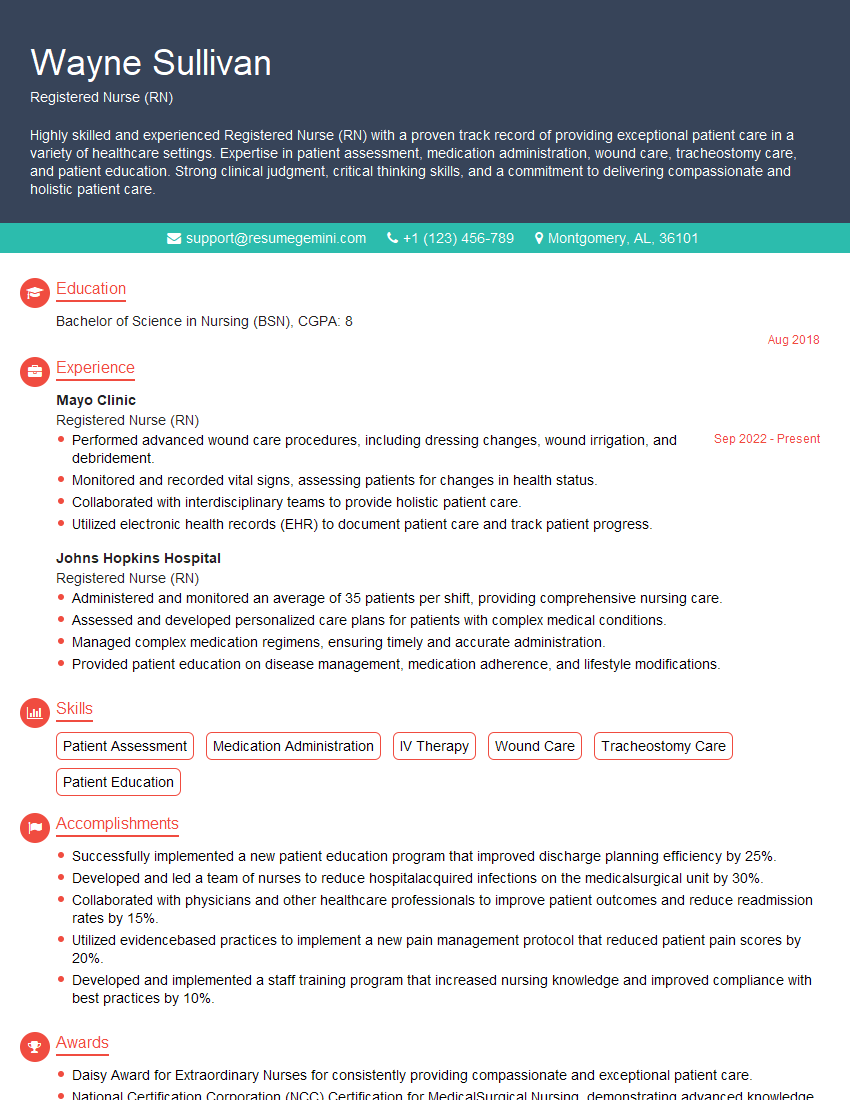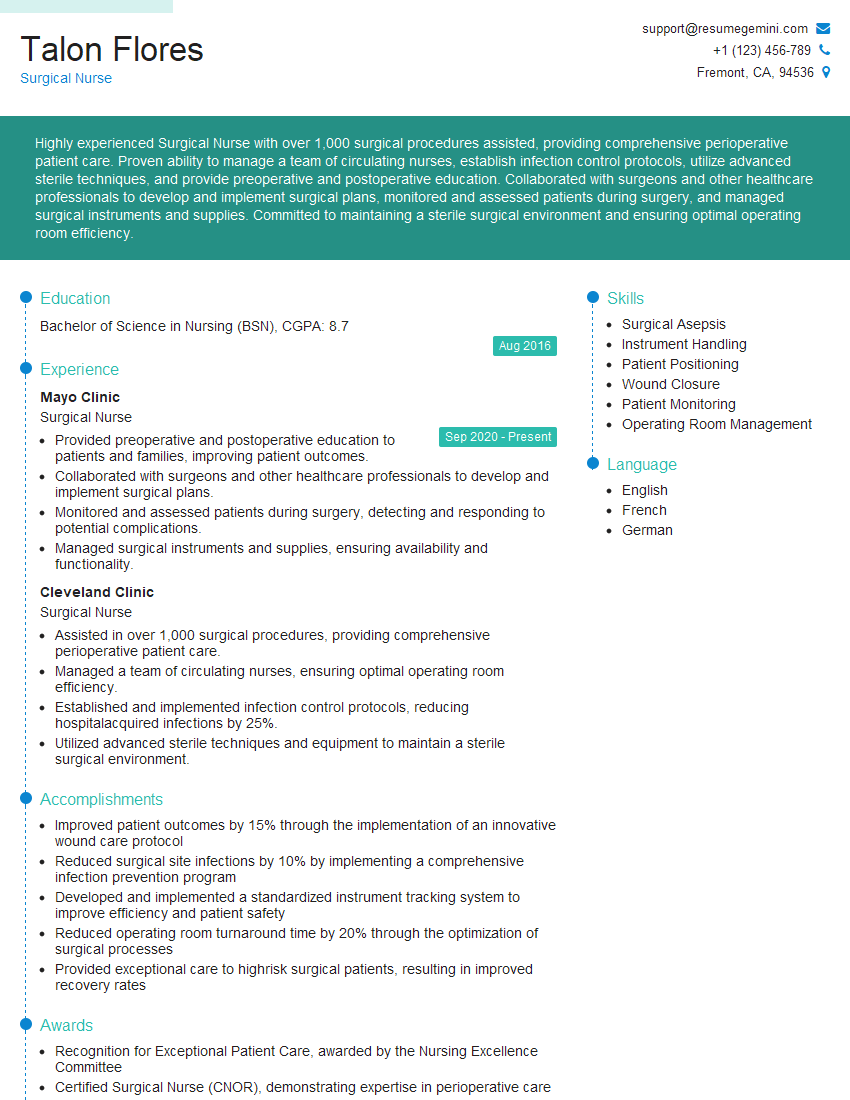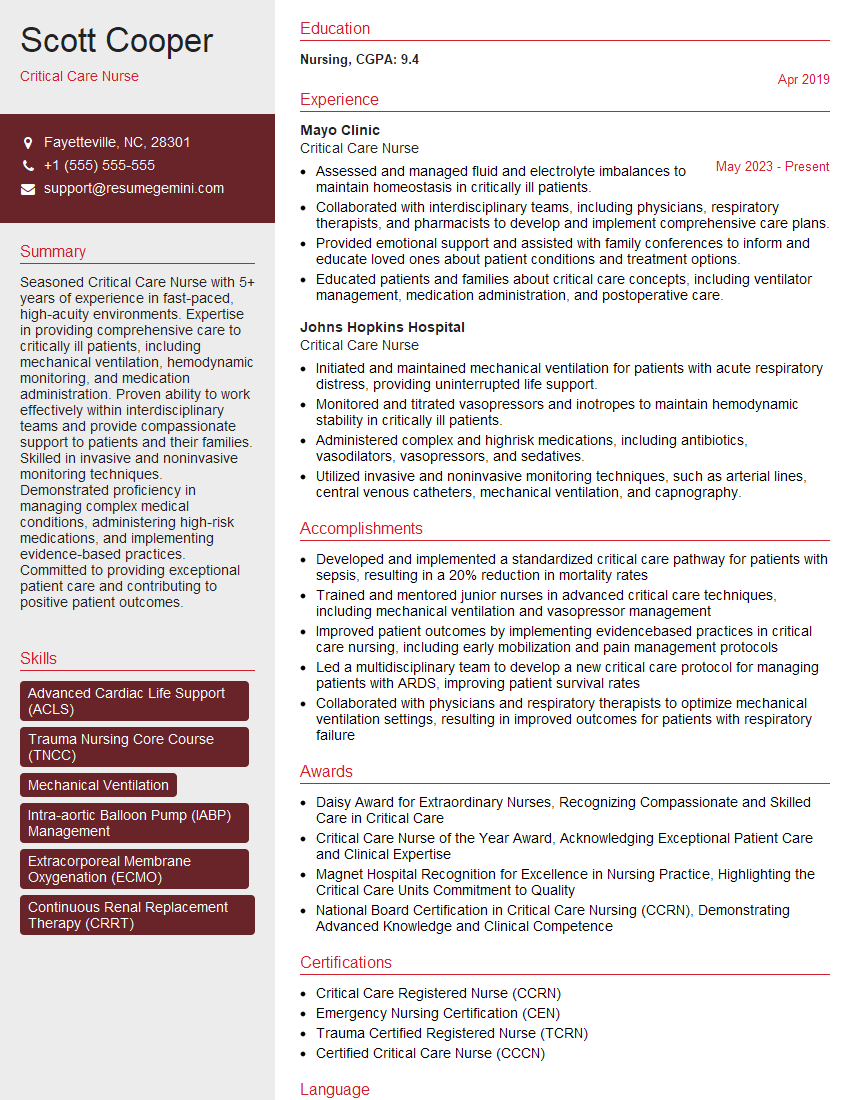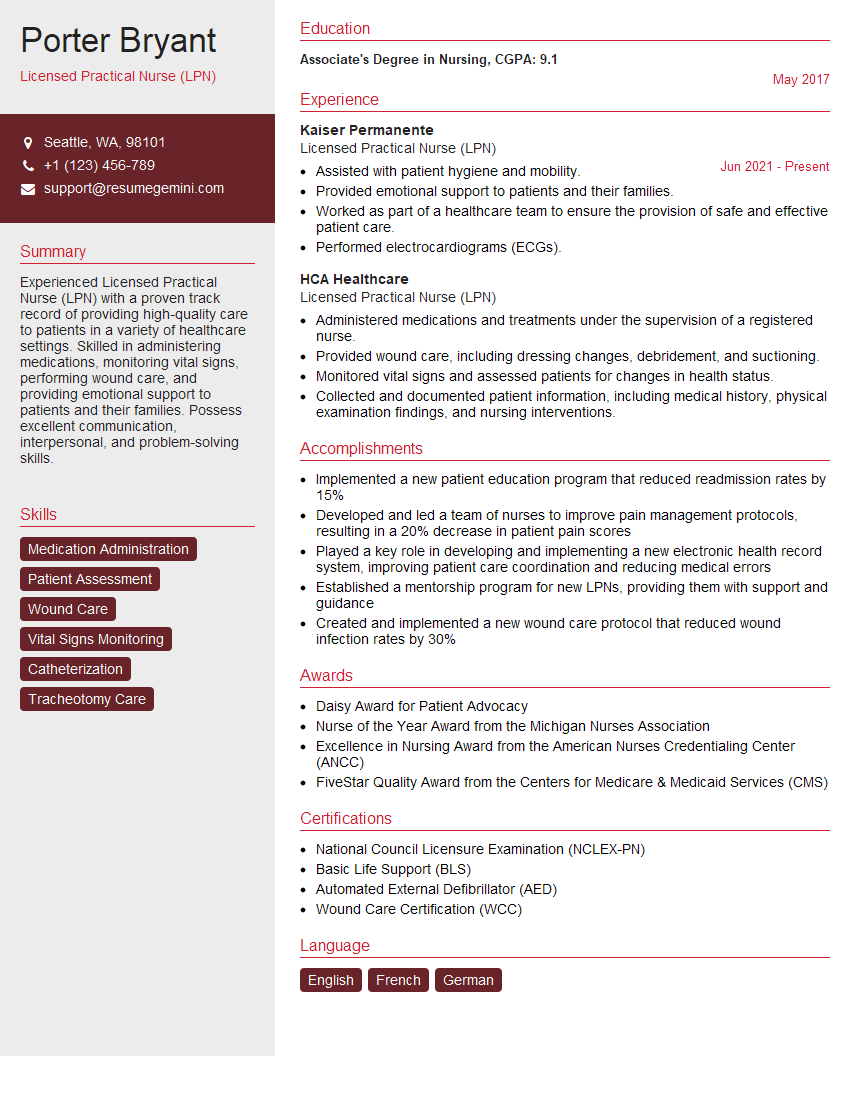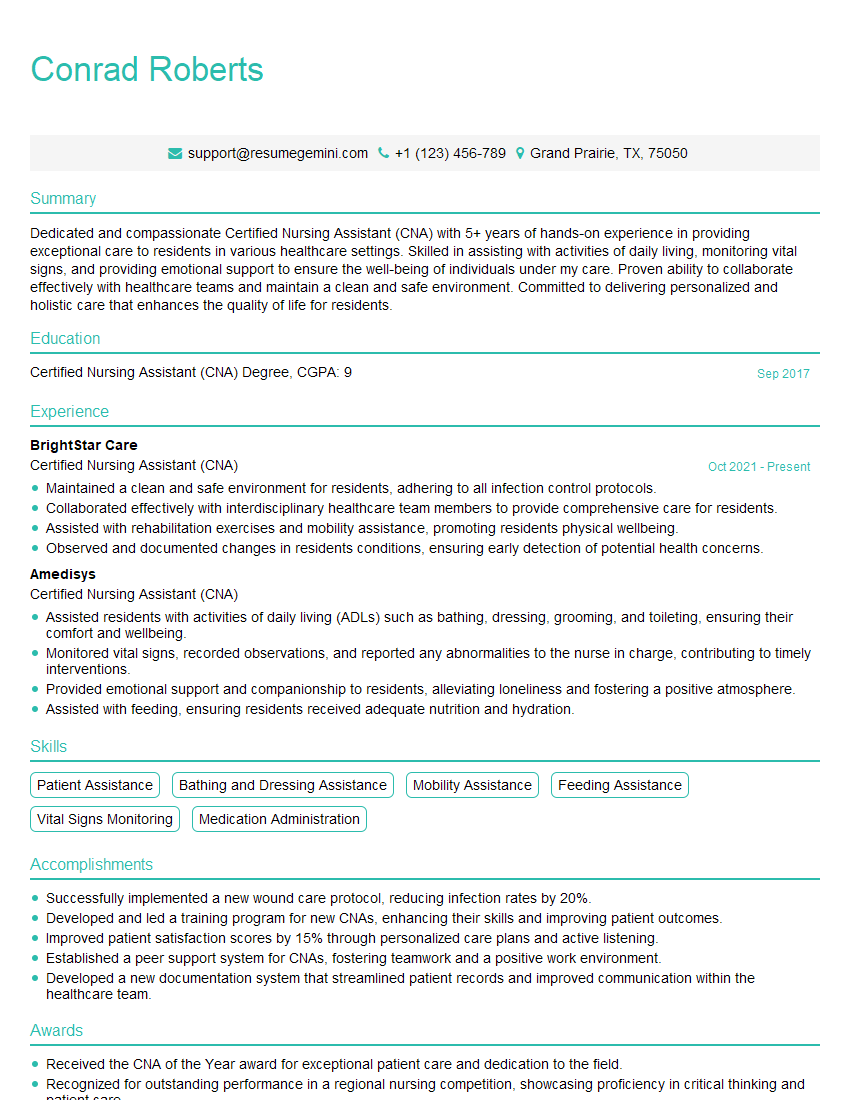Preparation is the key to success in any interview. In this post, we’ll explore crucial IV Preparation and Administration interview questions and equip you with strategies to craft impactful answers. Whether you’re a beginner or a pro, these tips will elevate your preparation.
Questions Asked in IV Preparation and Administration Interview
Q 1. What are the different types of IV fluids and their indications?
Intravenous (IV) fluids are solutions administered directly into a patient’s vein to provide hydration, electrolytes, medications, or nutrients. The type of fluid used depends entirely on the patient’s specific needs.
- Isotonic Solutions: These fluids have the same osmolarity (concentration of dissolved particles) as blood plasma. They expand the intravascular volume without causing fluid shifts between compartments. Examples include Normal Saline (0.9% NaCl) – commonly used for fluid resuscitation and maintaining hydration; Lactated Ringer’s (LR) – contains electrolytes similar to blood plasma and is often used for fluid replacement after blood loss or surgery; and 5% Dextrose in Water (D5W) – provides calories but is not truly isotonic, as the dextrose is metabolized, leaving free water.
- Hypotonic Solutions: These solutions have a lower osmolarity than blood plasma. They shift fluid from the intravascular space into the cells, hydrating them. 0.45% Saline is a common example, used to treat cellular dehydration.
- Hypertonic Solutions: These solutions have a higher osmolarity than blood plasma. They draw fluid from the cells into the intravascular space, increasing blood volume. Examples include D5NS (5% Dextrose in Normal Saline) and D5LR (5% Dextrose in Lactated Ringer’s), used to treat hyponatremia (low sodium levels) or to provide calories and hydration simultaneously.
Indications: The choice of IV fluid is dictated by the patient’s condition. For instance, a patient with severe dehydration might receive Normal Saline, while a patient with hyponatremia might require a hypertonic solution. Always consult physician orders and patient-specific needs.
Q 2. Explain the steps involved in preparing an IV solution.
Preparing an IV solution involves meticulous attention to detail to ensure patient safety. The steps generally include:
- Hand Hygiene: Thorough handwashing is paramount to prevent contamination.
- Gather Supplies: This includes the prescribed IV fluid bag, appropriate IV tubing (with an air vent if necessary), alcohol swabs, and gloves.
- Inspect the Solution: Check for clarity, discoloration, particulate matter, and expiration date. Discard any bag showing signs of damage or contamination.
- Spike the Bag: Using a sterile technique, insert the spike into the IV bag port, ensuring a secure connection to prevent leaks.
- Attach Tubing: Connect the tubing to the bag spike and prime the tubing by allowing fluid to flow through the line, removing any air bubbles. This prevents air emboli.
- Close the Roller Clamp: Once primed, close the roller clamp to stop fluid flow until the infusion is initiated.
- Label the Bag: Clearly label the bag with the patient’s name, the date, the time of preparation, the type and amount of fluid, and any additives.
Example: Preparing a D5NS bag involves following these steps precisely. Any deviation could compromise the sterility and safety of the infusion.
Q 3. Describe the proper technique for initiating an IV infusion.
Initiating an IV infusion requires a sterile technique and careful attention to patient comfort and safety. The steps are as follows:
- Hand Hygiene and Glove Application: Begin with thorough handwashing and don sterile gloves.
- Site Selection and Preparation: Choose an appropriate vein (usually in the forearm or hand) and clean the area with an antiseptic solution, allowing it to dry completely. Avoid areas with compromised skin integrity.
- Venipuncture: Insert the catheter into the selected vein at a shallow angle (10-30 degrees), advancing the catheter until flashback of blood is observed.
- Catheter Advancement and Securement: Advance the catheter into the vein and remove the needle, while simultaneously securing the catheter hub. Flush the catheter with saline to ensure patency.
- Dress the Site: Apply a sterile dressing to the insertion site to secure the catheter and protect it from infection.
- Connect Tubing: Connect the primed IV tubing to the catheter hub.
- Regulate the Flow Rate: Adjust the roller clamp on the tubing to achieve the prescribed flow rate.
- Document: Record the initiation time, site location, catheter size, type and amount of fluid infused, and any observations.
It is critical to minimize patient discomfort throughout the process. Explain each step to the patient and monitor for signs of discomfort or complications.
Q 4. How do you select the appropriate IV catheter size and insertion site?
Selecting the appropriate IV catheter size and insertion site is crucial for successful IV therapy and patient comfort.
Catheter Size: Catheter size is expressed by its gauge (G), with smaller gauge numbers indicating larger diameters. The choice of catheter size depends on the viscosity of the fluid being infused, the duration of the infusion, and the patient’s vein size. Thicker, more viscous fluids require larger catheters (smaller gauge numbers) to prevent clogging. For example, a 20G catheter is often used for routine infusions, while a 16G or 18G catheter might be chosen for rapid fluid resuscitation or blood transfusions.
Insertion Site: The insertion site should be selected based on patient comfort, ease of access, and vein condition. Preferred sites include the dorsal hand veins (metacarpal veins) and forearm veins (cephalic and basilic veins). Veins should be visible, palpable and relatively straight to facilitate catheter insertion. Avoid using veins that are fragile, sclerosed, or located near joints to prevent complications.
Example: For a patient requiring rapid fluid resuscitation, a larger catheter like an 18G would be placed in a larger vein in the forearm. For a patient receiving routine IV antibiotics over several hours, a 22G or 24G catheter in a hand vein may suffice.
Q 5. What are the potential complications associated with IV therapy, and how do you manage them?
IV therapy, while essential, carries potential complications. Prompt recognition and management are crucial.
- Infiltration: This occurs when the IV fluid leaks out of the vein into the surrounding tissue. Symptoms include swelling, pain, coolness at the site, and possibly blanching of the skin. Treatment involves stopping the infusion, removing the catheter, elevating the extremity, and applying warm or cold compresses (depending on the type of fluid).
- Extravasation: Similar to infiltration, but involves the leakage of a vesicant (irritant) medication into the surrounding tissue. This can cause severe pain, blistering, and tissue damage. Treatment is more aggressive and may involve local injection of hyaluronidase (an enzyme that breaks down hyaluronic acid in the tissues) to help disperse the medication.
- Phlebitis: Inflammation of the vein caused by irritation from the catheter. Symptoms include redness, warmth, tenderness, and possibly swelling along the vein. Treatment includes removing the catheter, applying warm compresses, and elevating the extremity.
- Thrombophlebitis: A more severe form of phlebitis, involving the formation of a blood clot within the inflamed vein. This requires medical attention and often involves anticoagulant therapy.
- Infection: Infection at the insertion site can lead to localized symptoms (redness, swelling, purulent drainage) or more systemic signs of infection (fever, chills). Prompt treatment with antibiotics is required. Proper aseptic technique is paramount in prevention.
- Air Embolism: Introduction of air into the bloodstream during IV insertion. This is a life-threatening emergency. Treatment involves placing the patient in a left lateral Trendelenburg position (lying on their left side with their legs elevated) and providing supportive care.
Management: Early detection is key. Regular monitoring of the IV site for any signs of complications is essential. Documentation of any complications and subsequent interventions is crucial.
Q 6. How do you verify the five rights of medication administration before initiating an IV infusion?
Verifying the five rights of medication administration is a cornerstone of safe IV therapy. This includes:
- Right Patient: Confirming the patient’s identity using two identifiers (e.g., name and date of birth) before administering any medication.
- Right Medication: Checking the medication order against the medication label to ensure that it matches. Double-checking the medication name, dosage, route, and frequency.
- Right Dose: Confirming that the prescribed dose is appropriate for the patient’s age, weight, and medical condition. Calculating the dose carefully and double-checking calculations.
- Right Route: Ensuring that the medication is administered via the correct route (in this case, intravenous).
- Right Time: Administering the medication at the scheduled time as per the physician’s orders.
Example: Before initiating an IV infusion of potassium chloride, I would verify the patient’s identity, ensure the correct medication and dosage are prescribed, confirm the IV route, and check the timing against the medication administration record.
Q 7. What are the signs and symptoms of infiltration, extravasation, and phlebitis, and how do you treat them?
Recognizing and managing these complications is essential for patient safety.
- Infiltration: Symptoms include swelling, pain, coolness at the insertion site, and possibly blanching of the skin. Treatment involves stopping the infusion, removing the catheter, elevating the extremity, and applying warm or cold compresses (depending on the fluid infused).
- Extravasation: Characterized by pain, swelling, blistering, and possible tissue necrosis. Treatment includes immediately stopping the infusion, removing the catheter, and contacting the physician, potentially requiring hyaluronidase injection.
- Phlebitis: Symptoms include redness, warmth, tenderness, and swelling along the vein. Treatment involves removing the catheter, applying warm compresses, and elevating the extremity. In more severe cases, antibiotics may be necessary.
Example: A patient receiving an IV infusion complains of sudden severe pain and burning at the IV site, with swelling and redness. This suggests extravasation. Immediate action is required, including stopping the infusion, notifying the physician, and potentially administering hyaluronidase. Thorough documentation of the event and subsequent treatment is essential.
Q 8. Explain the process of discontinuing an IV infusion.
Discontinuing an IV infusion is a crucial step requiring careful attention to detail and adherence to aseptic technique. The process aims to prevent complications like bleeding, infection, and infiltration.
- Turn off the infusion pump: This stops the flow of fluids immediately.
- Assess the insertion site: Check for signs of infection (redness, swelling, pain, drainage), infiltration (swelling, coolness around the site), or phlebitis (inflammation of the vein). Document your findings.
- Remove the tape securing the catheter: Gently remove the tape, avoiding any abrupt pulling that could damage the vein.
- Apply pressure to the site: Once the catheter is withdrawn, immediately apply firm pressure with a sterile gauze pad directly to the insertion site for at least 2-5 minutes or until bleeding stops. For patients on anticoagulants, this may require more extended pressure.
- Dispose of the catheter properly: Place the used catheter in a designated sharps container.
- Inspect the site: After removing pressure, inspect the insertion site for any further bleeding or hematoma formation. Document this in the patient’s chart.
- Apply a sterile dressing: Cover the insertion site with a sterile dressing if necessary.
- Document the procedure: Record the time of discontinuation, the condition of the insertion site, and any other relevant observations in the patient’s medical record.
Think of it like carefully removing a plug from a socket – you want to do it smoothly and safely to prevent damage.
Q 9. How do you calculate IV infusion rates?
Calculating IV infusion rates is essential to deliver medications or fluids at the correct speed. The formula is fairly straightforward, but accuracy is paramount.
The basic formula is: Volume (mL) / Time (hours) = Rate (mL/hr)
Example: A patient needs 1000 mL of Normal Saline (NS) over 8 hours. The calculation is 1000 mL / 8 hours = 125 mL/hr. The infusion pump should be set to deliver 125 mL per hour.
However, some medications are ordered in micrograms/kg/min or other units. In such cases, you’ll need to perform additional conversions. For instance, you may need to convert milligrams to micrograms, kilograms to pounds, and minutes to hours. It’s crucial to use the correct conversion factors to ensure accurate dosage. Always double-check your calculations before initiating the infusion. Many hospitals use computerized order entry and infusion calculators to reduce medication errors, but understanding the underlying principles remains vital.
Q 10. What are the different types of IV infusion pumps, and how do they work?
Various IV infusion pumps exist, each designed with different features and capabilities. The fundamental principle behind all of them is controlled delivery of fluids.
- Syringe pumps: These use syringes to deliver precise volumes of medication. They are often used for critical care medications requiring very small and accurate volumes.
- Volumetric pumps: These are the most common type, delivering precise volumes of fluids at pre-set rates. They use a roller clamp mechanism to regulate the fluid flow.
- Ambulatory pumps: Smaller and portable, these pumps allow patients to receive infusions while moving around. This is commonly used for pain management or antibiotic infusions at home.
- Smart pumps: These are sophisticated devices with features such as drug libraries and dose error reduction software. They can alert clinicians to potential errors such as incompatible medications or infusion rate outside of safe limits.
All pumps work by precisely controlling the flow of fluids through a system of tubing and rollers, ensuring accurate and safe delivery.
Q 11. How do you monitor an IV infusion site for complications?
Monitoring an IV infusion site is critical to prevent and manage complications. Regular assessment is key.
- Visual inspection: Check for redness, swelling, pain, warmth, hardness, or drainage at the site. These are signs of infiltration, phlebitis, or infection.
- Palpation: Gently palpate the area around the catheter for any tenderness, swelling, or coolness. Coolness is a sign of infiltration.
- Assessment of flow rate: Ensure that the infusion rate is as prescribed and that the fluid is infusing as expected.
- Observe the infusion line: Check for any kinks or obstructions in the tubing that might affect flow.
- Patient assessment: Inquire about any discomfort or symptoms the patient is experiencing related to the infusion.
Think of it like regularly checking a plant – you look for wilting (infiltration), pests (infection), or other signs of distress. Early detection allows for prompt intervention.
Q 12. Describe the procedure for flushing an IV catheter.
Flushing an IV catheter is done to maintain patency (keeping the line open) and prevent clotting. It’s a critical skill.
- Gather supplies: You’ll need a saline flush (usually 10 mL), gloves, and alcohol swabs.
- Assess the insertion site: Check for any signs of complications before initiating the flush.
- Clean the injection port: Use an alcohol swab to clean the injection port of the IV catheter, allowing it to dry before proceeding.
- Connect the flush: Using aseptic technique, connect the saline flush to the injection port.
- Flush the catheter: Gently push the saline through the catheter. Note any resistance or unusual symptoms.
- Disconnect the flush: Remove the saline flush and discard it appropriately.
- Observe the site: After flushing, monitor the site for bleeding, swelling, or pain.
The process is similar to clearing a clogged pipe – you use a pressurized stream (saline) to ensure free flow. This is important for medication delivery and preventing blood clots.
Q 13. What are the legal and ethical considerations related to IV therapy?
IV therapy carries significant legal and ethical responsibilities. These involve patient safety, informed consent, and adherence to regulations.
- Informed consent: Patients must understand the procedure, its benefits and risks, and give their informed consent before any IV therapy is initiated.
- Medication safety: Strict adherence to the six rights of medication administration (right patient, right drug, right dose, right route, right time, right documentation) is paramount to prevent medication errors.
- Aseptic technique: Maintaining strict aseptic technique during IV preparation and administration is essential to prevent infections.
- Documentation: Detailed and accurate documentation of the entire process, including any complications or interventions, is essential for legal and quality assurance purposes.
- Professional standards: Healthcare professionals must adhere to professional standards and guidelines set by regulatory bodies and professional organizations.
- Confidentiality: Patient information and medical records must be kept confidential.
Ethical practice involves prioritizing patient well-being, upholding professional integrity, and adhering to legal standards. The responsibility for safe and effective IV therapy rests on the entire healthcare team.
Q 14. How do you handle medication errors during IV preparation or administration?
Medication errors during IV preparation or administration are serious incidents with potentially life-threatening consequences. Prompt and effective response is vital.
- Immediately stop the infusion: If a medication error is suspected, immediately stop the IV infusion.
- Assess the patient: Monitor the patient closely for any adverse effects and provide supportive care as needed.
- Notify the physician: Report the error immediately to the attending physician or nurse manager.
- Document the error: Thoroughly document all aspects of the error, including the details of the mistake, actions taken, and patient response. This will be important for quality improvement measures and legal reasons.
- Follow institutional protocol: Adhere to the institution’s established protocol for reporting and handling medication errors. This often involves completing an incident report.
- Implement corrective actions: Collaborate with the healthcare team to identify the causes of the error and implement corrective actions to prevent similar incidents in the future.
Reporting and analyzing errors is crucial for learning and improving patient safety. It’s not about blame but about improving the system. Open communication and a culture of safety are essential.
Q 15. What are your strategies for maintaining sterility during IV preparation?
Maintaining sterility during IV preparation is paramount to prevent infection. We employ a multi-pronged approach, starting with meticulous hand hygiene – a thorough wash with an antimicrobial soap for at least 30 seconds. We then work in a designated clean environment, ideally a laminar airflow hood or a clean, well-lit area, free from dust and air currents. All equipment, including IV bags, tubing, needles, and syringes, must be sterile and checked for integrity before use. The use of sterile gloves is mandatory. We strictly adhere to aseptic techniques throughout the preparation process: avoiding touching sterile surfaces with ungloved hands, maintaining a sterile field, and discarding any contaminated materials appropriately. For example, if a vial of medication is touched by an unsterile object, the entire vial is immediately discarded. Any cracks or damage to vials or containers are noted, and the content is not used. We also practice careful handling of IV fluids, ensuring that the ports are cleaned before accessing them and employing the necessary precautions to prevent contamination during fluid addition or medication mixing. Regular training and competency assessment ensure that best practices are followed consistently, leading to patient safety.
Career Expert Tips:
- Ace those interviews! Prepare effectively by reviewing the Top 50 Most Common Interview Questions on ResumeGemini.
- Navigate your job search with confidence! Explore a wide range of Career Tips on ResumeGemini. Learn about common challenges and recommendations to overcome them.
- Craft the perfect resume! Master the Art of Resume Writing with ResumeGemini’s guide. Showcase your unique qualifications and achievements effectively.
- Don’t miss out on holiday savings! Build your dream resume with ResumeGemini’s ATS optimized templates.
Q 16. What is the difference between peripheral and central venous access?
Peripheral venous access involves inserting a catheter into a vein in the arm or hand, usually accessible with a smaller needle. It’s suitable for short-term infusions of fluids or medications. Think of it as accessing a smaller, easily accessible stream. In contrast, central venous access involves inserting a catheter into a larger vein, such as the subclavian, jugular, or femoral vein, which leads directly to the superior vena cava near the heart. This provides a larger vessel for faster and more reliable infusions of fluids, medications with high osmolarity, or long-term therapy. It’s like using a larger, faster-flowing river. Central lines, such as PICC lines, are preferred for long-term therapies, administering irritating medications, or delivering parenteral nutrition because they minimize the risk of vein irritation and damage compared to multiple peripheral IV attempts. The choice between peripheral and central access depends on the patient’s needs, the type of therapy, and the duration of treatment.
Q 17. Describe the process of inserting a PICC line.
Inserting a PICC line (Peripherally Inserted Central Catheter) is a sterile procedure requiring strict adherence to aseptic technique. First, the patient’s arm is prepped and draped using sterile technique. Ultrasound guidance is often used to identify a suitable vein, typically in the basilic or cephalic vein of the arm. A small incision might be needed to facilitate insertion. A guidewire is advanced through the needle into the vein, followed by the removal of the needle and the insertion of the PICC line over the guidewire. Once the catheter is in place, the guidewire is removed, and the catheter’s position is confirmed via chest x-ray to ensure it’s properly placed in the superior vena cava. The catheter is then secured with dressings, and the insertion site is monitored closely for any signs of infection or complications like thrombosis. Post-insertion education is given to the patient and/or their caregiver about catheter care, including dressing changes and potential signs of complications. We always document the entire procedure precisely. For example, we record the vein used, catheter length, X-ray confirmation, and patient education provided.
Q 18. How do you manage a patient experiencing an allergic reaction to an IV medication?
Managing an allergic reaction to an IV medication is a critical situation requiring immediate action. The first step is to immediately stop the infusion. Then, we assess the patient’s response – symptoms might include rash, itching, swelling, hives, shortness of breath, or anaphylaxis. Based on the severity, we administer appropriate treatment. This may include administering oxygen, epinephrine (in case of anaphylaxis), antihistamines (like diphenhydramine), or corticosteroids (like methylprednisolone) as prescribed by the physician. We closely monitor the patient’s vital signs (heart rate, blood pressure, respiratory rate, oxygen saturation), continuously assessing the severity of the reaction. We document all actions taken, including the time, the administered medications and their dosage, and the patient’s response. In serious cases, the patient may require immediate transfer to the intensive care unit for advanced support. For example, a patient experiencing anaphylaxis would receive prompt administration of epinephrine, oxygen, and IV fluids while being closely monitored. We also notify the physician immediately.
Q 19. Explain your understanding of fluid balance and electrolyte imbalances.
Fluid balance refers to the equilibrium between fluid intake and fluid output. Maintaining this balance is crucial for many bodily functions. Electrolyte imbalances occur when there’s an abnormal concentration of electrolytes (such as sodium, potassium, calcium, and magnesium) in the body’s fluids. These imbalances can significantly affect various physiological processes, potentially leading to serious consequences like cardiac arrhythmias or neurological dysfunction. Dehydration, for instance, leads to fluid deficit and potential electrolyte imbalance. This can be assessed by observing the patient’s clinical symptoms, monitoring intake and output, evaluating blood tests, and calculating fluid balance. On the other hand, fluid overload, often seen in heart failure patients, results in excess fluid and can lead to electrolyte dilution. Therefore, meticulous monitoring of electrolyte levels is crucial for detecting and correcting these imbalances. Treatment involves adjusting fluid intake and output, administering intravenous fluids to correct fluid deficits, or using diuretics to manage fluid overload. Regular blood work is used to monitor the effectiveness of treatment and to adjust the plan accordingly. A careful assessment of each individual patient’s situation is needed to prevent any adverse effects.
Q 20. How do you document IV therapy accurately and comprehensively?
Accurate and comprehensive documentation of IV therapy is non-negotiable. We use the electronic health record system (EHR) to document each step of the process: the type and amount of fluid administered, the medication given, the infusion rate, the time started and stopped, the patient’s response to the treatment, any adverse effects observed, and any interventions taken. We also document the insertion site, the type of catheter used (peripheral, central, PICC), and any relevant details about catheter care, such as dressing changes. Our goal is to provide a clear and detailed record that allows any healthcare professional to understand the patient’s IV therapy history at a glance. For example, precise recording of the medication’s dilution, timing of administration, and infusion rate is extremely crucial to ensure safety and efficacy. We also document any changes to the infusion plan and include the rationale behind the modification. This practice safeguards against errors, and provides useful data for evaluating patient outcomes and ensuring compliance with standards of care.
Q 21. What is your experience with different types of IV medications?
My experience encompasses a wide range of IV medications, including antibiotics (e.g., vancomycin, piperacillin/tazobactam), analgesics (e.g., morphine, fentanyl), antiemetics (e.g., ondansetron, promethazine), electrolytes (e.g., potassium chloride, sodium chloride), and various other medications depending on the patient’s condition. I am familiar with the different routes of administration, the compatibility of medications, and the potential adverse effects. I am trained on calculating appropriate dosages based on patient weight and renal function, and I’m adept at preparing and administering medications according to the physician’s orders while ensuring patient safety and adherence to all safety regulations. This includes understanding the necessary dilutions and ensuring compatibility with other IV fluids. For example, I have experience with preparing and administering chemotherapy drugs, which requires extra precaution and knowledge of safety procedures. Each medication has unique administration protocols, and adherence to them is critical for patient safety.
Q 22. What safety measures do you follow when handling cytotoxic drugs?
Handling cytotoxic drugs requires meticulous adherence to safety protocols to protect both the healthcare professional and the environment. Think of these drugs as extremely potent poisons – even minimal exposure can have severe consequences. Our primary focus is containment and prevention of accidental exposure.
- Dedicated work area: We use a designated laminar airflow hood or biological safety cabinet (BSC) for preparation, minimizing airborne contamination. Imagine it as a controlled environment, similar to a cleanroom, where the air is filtered to remove contaminants.
- Personal Protective Equipment (PPE): This is non-negotiable. We always wear double gloves (nitrile or equivalent), gowns, masks with eye protection, and shoe covers. This creates a barrier against spills or splashes.
- Spill kits: These are readily available and contain specialized materials for quickly and safely neutralizing cytotoxic spills. Think of it as a first aid kit, but for chemotherapy spills.
- Waste disposal: Cytotoxic waste is treated as hazardous material and disposed of according to strict guidelines. This involves special containers and labeling to ensure safe handling and incineration.
- Closed-system drug-transfer devices (CSTDs): These devices minimize exposure to airborne particles during drug preparation and administration, reducing the risk of inhalation.
- Regular training and competency assessments: Continuous education and regular checks are crucial to maintain proficiency and awareness of the risks associated with these potent drugs.
For instance, I recall an incident where a vial of a cytotoxic drug was accidentally dropped. Our immediate response, based on rigorous training, was to isolate the area, don appropriate PPE, and use the spill kit according to procedure. The situation was resolved safely and efficiently, preventing any exposure.
Q 23. Explain your knowledge of different types of IV cannulae.
IV cannulae are essential tools in intravenous therapy, varying in size and material to suit different patient needs and infusion requirements. They are essentially small tubes inserted into a vein to deliver fluids, medications, or blood products.
- Gauge (G): This refers to the diameter of the cannula; smaller gauge numbers indicate larger diameters (e.g., 18G is larger than 24G). Larger gauge catheters are suitable for rapid infusions or viscous fluids, whereas smaller ones are preferred for less irritating medications or in patients with fragile veins.
- Length: Cannula length varies depending on the vein’s location and depth. Shorter cannulae are typically used in superficial veins, whereas longer ones might be required for deeper venous access.
- Material: Most cannulae are made of polyurethane or Teflon, chosen for their biocompatibility and flexibility. These materials minimize vein irritation and reduce the risk of clotting.
- Types: Over-the-needle catheters (ONCs) are the most common type, where the needle is removed after insertion, leaving the catheter in place. Winged infusion sets (butterfly needles) are used for short-term infusions or blood draws. Peripherally inserted central catheters (PICCs) are longer catheters inserted into peripheral veins but intended to reach central veins for longer-term access.
For instance, when dealing with a patient requiring rapid fluid resuscitation, I would opt for a larger-gauge catheter, such as 18G, to ensure efficient fluid delivery. Conversely, for a patient receiving long-term antibiotic therapy, a smaller gauge catheter such as 22G or 24G might be preferred to minimize vein irritation.
Q 24. How do you troubleshoot common problems encountered during IV therapy?
Troubleshooting IV therapy issues requires a systematic approach, combining clinical judgment and practical skills. The key is to identify the problem accurately and take appropriate corrective action.
- Infiltration: If the IV fluid leaks into surrounding tissue, causing swelling and pain, the IV should be stopped immediately, the cannula removed, and a new site chosen. Cold compresses can help manage the swelling.
- Phlebitis: Inflammation of the vein, often characterized by redness, pain, and tenderness, necessitates stopping the infusion, removing the cannula, and possibly applying warm compresses or prescribing anti-inflammatory medication.
- Thrombophlebitis: This is a more severe form of phlebitis, involving clot formation within the vein. This requires prompt medical attention, including discontinuation of the infusion, removal of the cannula, and potentially anticoagulant therapy.
- Extravasation: Similar to infiltration, but potentially more serious, as it involves leakage of a vesicant (blistering) medication into the tissue. This requires immediate intervention, including stopping the infusion, administering antidote medication if appropriate, and possibly applying cold or warm compresses, depending on the medication.
- Occlusion: If the IV line becomes blocked, flushing with saline may resolve the issue. If not, the catheter may need to be replaced.
For example, I once encountered an IV infiltration. I promptly stopped the infusion, removed the cannula, applied a cold compress, documented the incident, and informed the physician. The patient’s symptoms improved within a few hours.
Q 25. What are the specific precautions for handling blood products?
Handling blood products demands stringent adherence to safety regulations to prevent transmission of bloodborne pathogens and allergic reactions. Every step, from storage to administration, must be precise.
- Verification: Before administration, we meticulously verify the patient’s identification, blood group compatibility (using cross-matching), and the product’s details. Two nurses independently verify this information to prevent errors.
- Storage: Blood products are stored under strictly controlled temperature conditions to maintain their viability and prevent bacterial growth. Improper storage renders them unusable.
- Inspection: We thoroughly inspect the blood bag for any signs of leakage, discoloration, or clots before administration. Any abnormalities would immediately disqualify the bag from use.
- Administration: Blood products are infused slowly, typically using a filter, to prevent any particulate matter from entering the patient’s bloodstream. We monitor the patient closely for any signs of adverse reactions, such as fever, chills, or hives.
- Disposal: Used blood bags and administration sets are disposed of as biohazardous waste, using appropriate containers and following strict infection control procedures.
A crucial aspect is the use of the ‘two-nurse check’ – a mandatory safety measure to eliminate errors before transfusing blood. Imagine it as a final checkpoint to ensure compatibility and patient safety before proceeding.
Q 26. Describe your experience with electronic medication administration records (eMAR).
Electronic Medication Administration Records (eMARs) are indispensable in modern healthcare settings, providing a digital record of medication orders, administration, and documentation. I have extensive experience using eMAR systems to streamline the medication process and improve safety.
- Order entry and verification: Physicians input medication orders electronically, and the system verifies against the patient’s profile and medication allergies. This eliminates errors associated with manual transcription.
- Medication dispensing: eMARs often integrate with automated dispensing cabinets, providing secure access to medications and tracking their usage. This ensures accuracy and accountability.
- Bar code scanning: Many eMAR systems utilize barcode scanning to verify medication and patient identity before administration. This helps prevent medication errors significantly.
- Real-time tracking: eMARs provide real-time tracking of medication administration, ensuring timely delivery and reducing medication delays. Any discrepancies are immediately highlighted.
- Reporting and analytics: eMARs generate comprehensive reports and analytics that help track medication usage, identify trends, and improve patient safety protocols.
In my experience, eMARs have greatly reduced medication errors and enhanced the overall efficiency of our medication administration processes. The ability to track medication in real time and generate reports provides valuable insights into our workflow and areas for improvement.
Q 27. How do you maintain patient confidentiality while administering IV medications?
Maintaining patient confidentiality is paramount. When administering IV medications, we strictly adhere to HIPAA regulations and hospital policies to protect sensitive patient information.
- Access restrictions: We only access patient information that is directly relevant to medication administration. Access to the electronic health record is password-protected and audited.
- Secure communication: Discussions regarding patient care are kept confidential and only shared with authorized personnel.
- Data protection: We follow protocols to ensure the security of electronic patient data, including password management and adherence to data breach protocols.
- Physical security: We safeguard paper-based documentation, maintaining it in secure locations, and disposing of it properly when no longer needed.
- Patient education: We are transparent with patients regarding their medication and treatment plan, ensuring they feel empowered to participate in their healthcare decisions.
For example, we never discuss patient details in public areas. Discussions about a patient’s medication or condition are limited to those directly involved in their care, and within a private setting.
Key Topics to Learn for Your IV Preparation and Administration Interview
- Aseptic Technique: Understanding and demonstrating proficiency in maintaining a sterile environment during IV preparation and administration. This includes proper hand hygiene, gowning and gloving procedures, and environmental control.
- Medication Calculations: Accurate dosage calculations and conversions are crucial. Practice solving various medication calculation problems to build confidence and accuracy.
- IV Solutions and Additives: Become familiar with different types of IV fluids, their compatibilities, and the safe administration of medications added to IV bags. Understanding potential incompatibilities is essential.
- Venipuncture Techniques: Mastering proper venipuncture techniques, including site selection, insertion, and securing the IV catheter. Be prepared to discuss different catheter sizes and their applications.
- Infusion Rates and Pumps: Calculating and adjusting infusion rates according to physician orders and using various infusion pumps correctly. Troubleshooting common pump malfunctions is also important.
- Complications and Interventions: Be prepared to discuss potential complications like infiltration, phlebitis, and extravasation, and the appropriate interventions for each.
- Documentation and Reporting: Accurate and timely documentation of all procedures, observations, and any complications encountered is crucial. Familiarize yourself with common charting practices.
- Legal and Ethical Considerations: Understand the legal and ethical responsibilities associated with IV therapy, including patient rights and informed consent.
- Patient Assessment and Monitoring: Discuss your ability to assess the patient’s condition before, during, and after IV administration, including vital signs monitoring and recognizing adverse reactions.
Next Steps
Mastering IV Preparation and Administration opens doors to rewarding and challenging careers in healthcare. To stand out, a well-crafted resume is essential. An ATS-friendly resume increases your chances of getting noticed by recruiters. We recommend using ResumeGemini, a trusted resource for creating professional and effective resumes. ResumeGemini provides examples of resumes tailored specifically to IV Preparation and Administration roles, helping you present your skills and experience in the best possible light. Take the next step towards your dream job today!
Explore more articles
Users Rating of Our Blogs
Share Your Experience
We value your feedback! Please rate our content and share your thoughts (optional).
What Readers Say About Our Blog
These apartments are so amazing, posting them online would break the algorithm.
https://bit.ly/Lovely2BedsApartmentHudsonYards
Reach out at [email protected] and let’s get started!
Take a look at this stunning 2-bedroom apartment perfectly situated NYC’s coveted Hudson Yards!
https://bit.ly/Lovely2BedsApartmentHudsonYards
Live Rent Free!
https://bit.ly/LiveRentFREE
Interesting Article, I liked the depth of knowledge you’ve shared.
Helpful, thanks for sharing.
Hi, I represent a social media marketing agency and liked your blog
Hi, I represent an SEO company that specialises in getting you AI citations and higher rankings on Google. I’d like to offer you a 100% free SEO audit for your website. Would you be interested?
